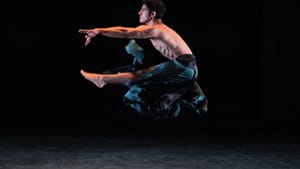Stay in the Loop
BSR publishes on a weekly schedule, with an email newsletter every Wednesday and Thursday morning. There’s no paywall, and subscribing is always free.
Dancing coast to coast
Annenberg Center presents Mark Morris Dance Group's 'Dances to American Music'

Mark Morris, artistic director of Mark Morris Dance Group (MMDG), is known for innovation in the shapes he creates onstage and for his use of music. How fitting, then, that two of the four works in Dances to American Music were performed to music by Lou Harrison, a frequent collaborator, played live by the MMDG Music Ensemble.
The show is part of Morris’s new residency at the Annenberg Center. As its inaugural artist-in-residence, Morris also curated a series of American musical films; these four movies play at Annenberg throughout February.
Joy and fear
Dances to American Music opened with “Pacific,” set to Harrison’s "Trio for Violin, Cello, and Piano." The dance highlighted the way Morris’s choreography blends drama and beauty. For instance, dancers lunged and moved their arms in time to piano notes, then scattered to the corners of the stage before exiting. Fluid lifts were combined with deep pliés.
All eight dancers moved skillfully, though Mica Bernas stood out because of the joy on her face. The dancers also performed identical movements in perfect sync, particularly notable because the group included dancers of different sizes and was equally male and female.
Martin Pakledinaz's costumes echoed the striking yet appealing quality of the dancing and reinforced the suggestion of gender neutrality, with dresses for the women and flowing skirts for the men. Warm lighting by James F. Ingalls set the tone, and I wondered if the blue, green, and red costumes might reflect the West Coast’s ocean, mountains, sun, and sand, or fire. “Pacific” was my favorite of the four works.
The second piece, “Mosaic and United,” was less accessible. Here were Morris’s signature changes of shapes and pace, with dancers running on and offstage, then turning slowly or standing in stillness. But the music — Henry Cowell’s "String Quartet No. 3 and No. 4" — used violins, a viola, and a cello to produce eerie sounds suggestive of a scary movie. The movement mirrored the music’s strangeness.
It was interesting to watch, if not always pleasant. At one point, dancers crawled across the floor; at another they twitched their hands and feet. The strongest section of “Mosaic and United” drew upon its repetition of mechanical movements, as when dancers walked stiff-legged like toy soldiers. Here, Lesley Garrison moved around other dancers who stayed still. When Garrison spun them, she seemed to set them in motion, as if winding up a toy. Costumes designed by fashion designer Isaac Mizrahi resembled silky pajamas.
Gender blending
Mizrahi also designed the costumes for “Three Preludes,” a solo performed by Laurel Lynch. This energetic dance paired a black outfit with white accents, including gloves and spats, and exaggerated hand gestures and arm movements suggesting movie musicals and silent film. I thought of Mickey Mouse and his big white gloves, a fittingly cheerful image for this dance and its musical accompaniment, George Gershwin’s “Preludes for Piano,” played by Colin Fowler.
Hands also featured in the last dance, “Grand Duo,” this time undulating in darkness before reaching up into a spotlight. Once again, Morris named the dance after its music, Harrison’s “Grand Duo for Violin and Piano.” This piece helped clarify what I see as Morris’s signature style: constantly shifting, asymmetrical groupings of dancers, and a gender-free approach to choreography.
“Grand Duo” included the synchronized movements of male and female dancers that also appeared in “Pacific” and “Mosaic and United,” along with costumes that blurred gender lines: men in skirts and culottes, and women in dresses and pants. As if to enhance the sense of gender fluidity, dancers formed trios instead of the traditional male-female duo, and these groups came together, split apart, and formed anew with different members.
Morris’s innovations may not seem as daring and profound today as they were in the 1990s, when each of the four works in Dances to American Music premiered. Yet they all contain Morris’s artistic fingerprint: a disregard for artificial boundaries.
What, When, Where
Dances to American Music. Choreography by Mark Morris, music by MMDG Music Ensemble. Mark Morris Dance Group. February 9-10, 2018, at the Annenberg Center for the Performing Arts, 3680 Walnut Street, Philadelphia. (215) 422-4580 or annenbergcenter.org.
Sign up for our newsletter
All of the week's new articles, all in one place. Sign up for the free weekly BSR newsletters, and don't miss a conversation.
 Melissa Strong
Melissa Strong